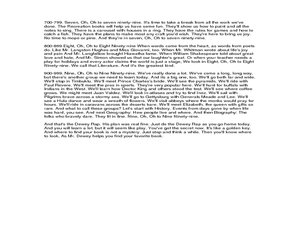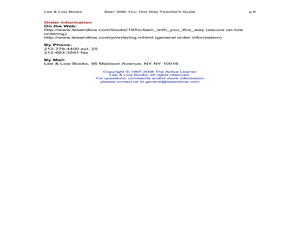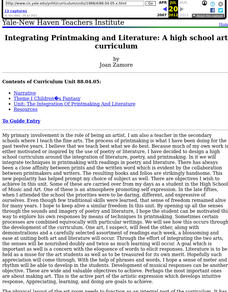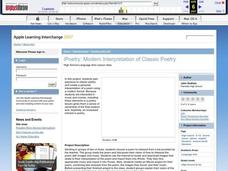Curated OER
Music In Your Neighborhood - Lesson 6
Learners demonstrate an awareness of music as part of daily life. They recognize that music is found throughout their neighborhood and see that music is found in neighborhoods of other cultures.
Curated OER
Feel the Music
Students identify and demonstrate a positive learning attitude. They also demonstrate responsible emotional and cognitive behaviors and identify how to communicate clearly in oral, artistic, written, and nonverbal form. Finally, students...
Curated OER
The Sound of Music: Do-Re-Mi
Seventh graders create a simple melody using the Solfedge syllables. For this melody lesson, 7th graders watch the movie The Sound of Music and focus on the "Do Re Mi" clip. Students examine solfege syllables and create a melody using...
Curated OER
Irregular Word Fluency, Musical Chairs
Students study language. In this word fluency instructional activity, students play a version of Musical Chairs in which they must correctly say an irregular word, pulled from a bag, to keep their chair. The game is played with a small...
Curated OER
Poems, Prayers, Promises, and Possibilities: The Music of Poetry
Twelfth graders express themselves through poetry. They discover the connection between their music and the music of poetry and hear their work and how the sound of a poem or an analytical paper improves their written work. They...
Curated OER
Music Appreciation Lesson
Students discover the freedom of dance by performing physical expression with music. For this physical education lesson, students discuss ways their body can make noise such as snapping, patting, or stomping. Students utilize their...
Curated OER
Understanding Human Rights Through Music And Poetry
Tenth graders discuss human rights. They brainstorm and listen to and read examples of music and poetry that deal with human rights and oppression. They choose one poem or song to analyze, looking for theme, oppression, and historical...
Curated OER
Dewey Rap
Fourth graders locate books in the library. In this Dewey Decimal System lesson, 4th graders listen to the Dewey Rap via power point or audio file. Students view a card from the Dewey system in their library and practice finding the book...
Curated OER
Dewey Decimal Rap
Students analyze four books and find the appropriate number in the Dewey Decimal System. For this Dewey Decimal System lesson, students compare their analysis with the reason they are placed in the library. Students create a rap and make...
Curated OER
Bein' With You This Way
Students complete pre reading, writing, during reading, and interdisciplinary activities for the book Bein' With You This Way. In this reading lesson plan, students complete journal entries, answer short answer questions, have...
Curated OER
Introduce Vocabulary: Rap a Tap Tap
Students are read Rap a Tap Tap, by Leo & Diane Dillon. In this vocabulary focused instructional activity, students discover the definitions of at least three Tier Two words. They discuss the meanings of the words, as a group, both...
Curated OER
Enhancing Literacy with Podcasting
Pupils write stories, print hard copies, and use the GarageBand program to add music and record the narrations. A handout to download, of instructions is included in this early-elementary lesson.
Curated OER
The City in Black and White and Color: An interdisciplinary approach to teaching life in the city using literature, social studies, art, and photography.
Students design an artistic and literary collage of contemporary urban life that seeks to interpret, analyze, and evaluate its mettle. They integrate their impressions of urban life with established views, thereby enriching their...
Curated OER
Beat the Heat
First graders are introduced to the concept of vowel digraphs. They identify the digraph /ea/ in written and spoken language. After a brief discussion, 1st graders apply the rule for identifying and spelling words containing the /ea/...
Curated OER
Words Beginning with P and R Homonyms
In this words beginning with P and R homonyms, 4th graders complete ten sentences by choosing the correct homonym beginning with P or R.
Curated OER
Word Art with King's Words
Students investigate equality and racism by creating a word art project. In this civil rights instructional activity, students discover the life of Martin Luther King Jr. and create a word art project using the Internet site Wordle...
Curated OER
The Language of the Civil Rights Movement:
Tenth graders study the poetry of the US Civil Rights movement and the Black Arts movement over a 12 day period. They author a website showing works of poetry that students have chosen to analyze and relate to these movements.
Curated OER
Integrating Printmaking and Literature: A high school art curriculum
Students integrate techniques in printmaking with readings in poetry and literature. They read various pieces of student literature and poetry, and create prints using various printmaking techniques.
Curated OER
Art Transitions: Morphs
Students identify artistic expression by participating in a morph activity. In this art analysis instructional activity, students identify the work of Keith Haring and examine some of his flip books. Students practice creating artistic...
Curated OER
Long Vowels With Clifford
Learners recognize long vowel sounds by reading and listening to a story that highlights words with long vowel sounds. They then construct an original story. They use picture clues to aid comprehension, and match words with similar vowel...
Curated OER
Sheryl Crow and Willie Nelson - Lesson 1
Appeal to your music lovers with this lesson. Middle and high schoolers listen to and describe music from contrasting styles. They identify the common elements between gospel and bluegrass music and have a class discussion regarding the...
Curated OER
iPoetry: Modern Interpretation of Classic Poetry
Students interpret a piece of poetry with images and music in a movie project.
Curated OER
What's Wrong - Intensive Reading
There are different types of reading meant for different texts. Discuss four of these with your emerging readers. When does one perform an extensive or intensive reading? When does one skim or scan a text? How are these all different?


